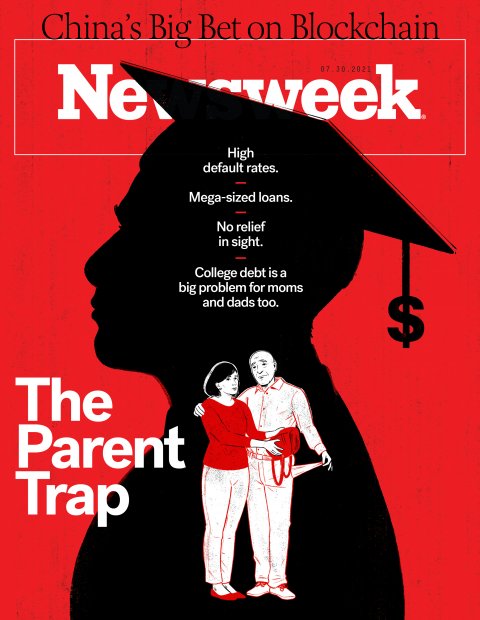About a quarter of all the money lent by the federal government last year to help families pay for college went to parents, who have sharply ramped up borrowing in recent years to cover high tuition costs.
Over the past decade, even as loans to undergraduates fell, parent borrowing under the federal PLUS loan program increased 16 percent, according to the College Board. That's pushed parents' total PLUS-loan debt to over $103 billion, or an average of $28,700 per borrower, the Department of Education reports, with billions more owed on private college loans, held solely in the parent's name or co-signed with children.
While borrowing for college can be a lifeline to helping your child obtain a degree, taking on such debt can also saddle you with high monthly payments that strain your wallet and threaten your future financial security in retirement.
A new Newsweek analysis of parent-loan data recently released by the federal government shows how quickly many families run into serious problems: About one in 10 parents default or are seriously late with payments within just two years of their child leaving college. And at more than 150 schools out of the nearly 1,000 colleges and universities in the database, parent default and delinquency rates hit 20 percent or more.
So before you borrow to help foot the bill for your kid's tuition, here's what you need to know to manage the loans wisely and avoid your own personal student debt crisis.
Before You Apply
Know your true cost. Some schools include Parent PLUS loans in the financial aid package presented to accepted students, creating confusion about the true cost of attendance. "Many families, especially those whose children are first-generation U.S. college students, don't realize this is a loan because of how it shows up on the aid letter," says Betsy Mayotte, president of The Institute of Student Loan Advisors. If the aid package is difficult to decipher, reach out to the financial aid office for help and a breakdown without the PLUS loan.

Max out student loans first. Federal student loans for undergraduates carry interest rates of 3.73 percent for the 2021-2022 school year, almost half of the 6.28 percent rate for parents under the PLUS loan program. Loans to students also come with a wider variety of repayment plans, and may offer partially subsidized interest. So before you even consider a PLUS loan, have your child borrow in their own name first: up to $5,500 for freshmen, $6,500 for sophomores, $7,500 for juniors and seniors. If you have the financial means, you can always help them with the payments later.
Calculate the hit to your lifestyle. Because you will likely be taking out more than one PLUS loan to cover your child's education, it's important to think long-term. If you borrow $15,000 this year, you'll owe $170 a month for the next 10 years. Factor in similar borrowing for another three years and you'll be $60,000 in debt and owe $679 a month. Breaking it down this way shows the loan's impact on your future ability to afford day-to-day expenses, save for retirement or pay off other debt, like your mortgage.
Look into other ways to pay. Check the online databases at FastWeb.com and the CollegeBoard for scholarship opportunities. Some schools, such as Clarkson and Purdue, offer income-sharing agreements, in which they provide a set amount toward tuition in exchange for a percentage of the student's post-graduation income for a fixed period. Tuition installment plans, which spread the cost of college over a 10-month period, rather than a lump sum, can also make payments more affordable.
Consider other loans. Banks are offering home equity lines of credit with rates as low as 2.5 percent—the average is 4 percent—no origination fee and low or no closing costs. That makes them a compelling alternative to a PLUS loan if you're a homeowner with a healthy amount of equity and a credit score of at least 620 (though a 740-plus score will snag the best rates). Private parent loans charge interest rates as low as 3 percent and have no origination fees but you'll miss out on the protections federal loans provide, such as forgiveness if you become disabled or if the student dies.

After You're Approved
Borrow as little as possible. PLUS loans allow you to borrow the full cost of attendance, without regard to your ability to afford the payments. Just because they let you borrow that much doesn't mean you should take them up on it. A good rule of thumb, says financial aid expert Mark Kantrowitz: Limit your total education debt for all children to no more than your annual household income—and less if you're within 10 years of retirement.
Start repaying immediately. Unlike loans to students, payments on parent loans begin as soon as the money is doled out. You can defer for up to six months after your child graduates but interest will continue to accrue; if you borrow, say, $15,000, with a 6.28 percent interest rate and 10-year repayment plan, that loan will balloon to $19,240 by the time repayments start. "If you can't afford the payment right now and plan to defer, that's a sign that you shouldn't be borrowing that amount," says Mayotte.
Let your employer help. About 8 percent of employers provide workers with student loan repayment assistance, including Aetna, Google and Hulu, according to the Society for Human Resource Management. While these programs are often targeted toward younger employees, most of them also apply to older workers with Parent PLUS loans, says Kantrowitz. More companies are expected to add this perk, too, thanks to pandemic legislation that made up to $5,250 of such assistance a tax-free benefit to employees through the end of 2025.

Let Uncle Sam help. PLUS loan borrowers can deduct up to $2,500 in student loan interest a year from their taxable income, without itemizing. The benefit is gradually reduced if your income is between $140,000 and $170,000 for married couples, or $70,000 and $85,000 for single or head of household filers. Earn above those amounts and you can't claim the deduction at all. But for those who can, the break is worth up to $600.
Catch a break. Struggling financially? Don't simply stop making payments, which can result in the government garnishing your wages, Social Security benefits or tax refunds. If the problem is temporary, you can apply for forbearance, or a pause in payments, for up to 12 months. Alternatively, you can reduce monthly payments by switching to a 25-year repayment plan, from the standard 10 years, or an income-contingent plan that will limit payments to 20 percent of your discretionary income (after 25 years, any remaining balance is forgiven). The downside of all these options: You'll pay more in interest and it'll take longer to get out of debt—you could be paying well into your retirement or even for the rest of your life.














